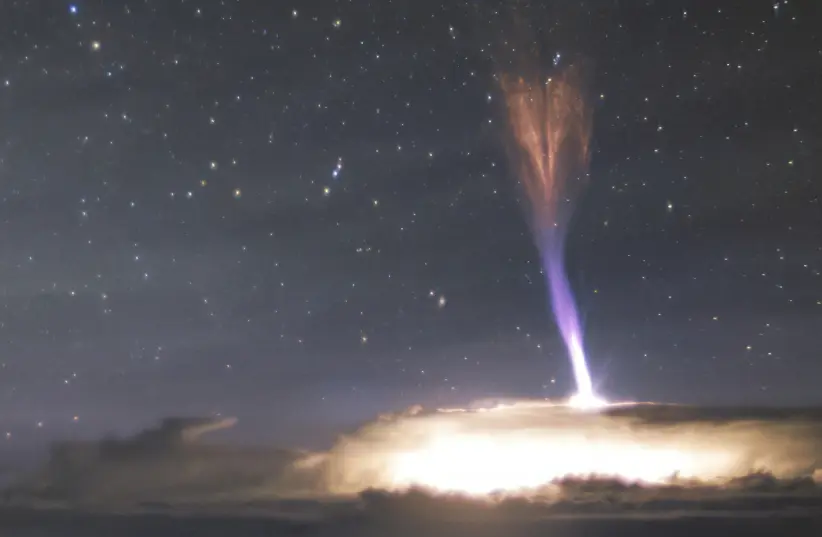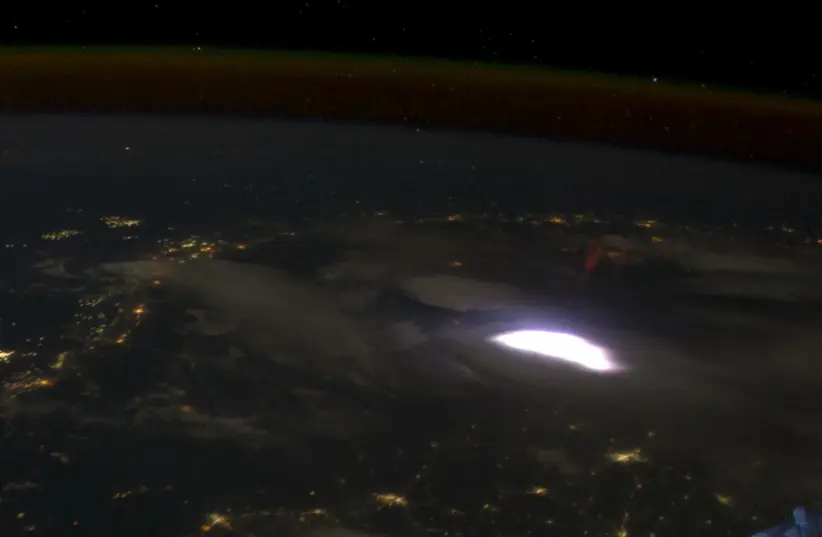
For the first time, researchers have mapped the 3-D structure of a gigantic supercharged lightning bolt jet. These jets look just as awesome as they sound and are generated during thunderstorms as a type of lightning. But unlike traditional lightning that discharges electricity downward from the clouds to the ground, these very rare jets shoot upward from the top of the thunderstorm toward the edge of space in less than a second.
Only five such jets are detected, on average, every year and the jet chosen by the researchers for their study is the strongest gigantic jet ever recorded. It discharged above Oklahoma, rising 50 miles into space and carrying 100 times as much electrical charge as a typical thunderstorm lightning bolt. Now that scientists are equipped with the information they need, they can untangle the structural features of gigantic jets and how they form.
“We were able to map this gigantic jet in three dimensions with really high-quality data,” said Levi Boggs, a research scientist at the Georgia Tech Research Institute (GTRI) and the new study’s corresponding author. “We were able to see very high frequency (VHF) sources above the cloud top, which had not been seen before with this level of detail. Using satellite and radar data, we were able to learn where the very hot leader portion of the discharge was located above the cloud.”
The investigation involved satellite, radar, and radio-wave data that was used to reassemble the gigantic jet. But before turning to these fancy pieces of tech, it all started with a lucky photograph of the Oklahoma jet taken by a citizen scientist who eventually showed it to Boggs in 2018. It was later that Boggs and colleagues turned to the digital archives in an effort to piece together this electric jigsaw puzzle.

Luckily, the researchers had data at their disposal from two separate satellites that had optical lighting instruments. Using these two separate angles, the researchers were able to develop a 3D model of the jet, showing it had discharged over an area of around 50 kilometers by 50 kilometers, propagating all the way to the lower ionosphere to an altitude of around 90 kilometers, or to the very edge of space. The model was refined by high-frequency electromagnetic data from nearby antennas close to the thunderstorm, along with ground-based lightning detection networks in the area.
It was really a huge stroke of luck that the most powerful gigantic jet detected so far happened to form right next to a very high-frequency lightning mapping system, as well as within range of ground-based weather radars and space-based satellites.
This work confirmed to the researchers that the high frequencies emitted by lightning are actually caused by small tendril-like streamers of electricity propagating from the tip of the developing lightning bolt. “The strongest electric current flows significantly behind this tip in an electrically conducting channel called a leader,” said co-author Steve Cummer, professor of electrical and computer engineering at Duke University.

But how do these gigantic jets form? When normal lighting is triggered in a thunderstorm, the ground is positively charged, while the bottom and top of the cloud are negatively and positively charged, respectively. But in gigantic jets, this cloud-to-ground discharge is suppressed because there’s a buildup of negative charge. The uppermost layer of the cloud, which is normally positive, is weakened, so the gigantic jet relieves the buildup of excess charge in the only direction it can: up.
How exactly this charge suppression takes place is not really well understood — and it may take a while before scientists get the full picture. That’s because gigantic jets are exceedingly rare and occur in unpredictable conditions. The stars happened to align with the Oklahoma jet, but we won’t be this lucky for the next one or the one after that. It’s unclear how frequently these jets occur. Scientists detect around five per year, but there are indications there could be tens of thousands yearly in Earth’s atmosphere.
Although challenging, hunting for gigantic jets may pay off in the long run. These jets may severely impact the operation of low-Earth orbit satellites. As more and more of these satellites are launched into space — with SpaceX alone planning on launching a couple thousand more for its Starlink internet network in the next few years — the risks posed by these jets could grow significantly.



